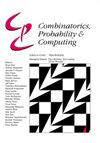芥子硫脲铜(Ⅱ)配合物的光催化降解及抗菌研究
IF 0.8
4区 数学
Q3 COMPUTER SCIENCE, THEORY & METHODS
引用次数: 1
摘要
本研究的目的是合成、研究和分析光催化降解动力学。合成了芥子硫脲铜配合物,并通过红外光谱、核磁共振、ESR对其进行了表征。以溶液形式的ZnO为催化剂,使用不同组成的非极性溶剂苯和极性溶剂甲醇,研究了铜(II)-芥子硫脲络合物的光催化降解。铜(II)配合物对金黄色葡萄球菌的抗菌活性也得到了研究。在不同的时间间隔后用分光光度法测量O.D.,以测量复合物的降解。绘制了2+log O.D.(吸光度)与时间的关系图,发现其为线性关系。多相光催化遵循伪一级反应动力学。目前的研究表明,CMT复合物在不同浓度下表现出抗菌活性。对CMT配合物的光催化降解速率进行了研究和分析。研究发现,复合物的浓度、催化剂的用量、光照强度、溶剂极性等参数不同,其降解速率也不同。天然芥子油衍生的CMT复合物对可能引起皮肤病的金黄色葡萄球菌的生长具有抑制作用。本文章由计算机程序翻译,如有差异,请以英文原文为准。
Photocatalytic Degradation and Antibacterial Study of Copper(II) Mustard Thiourea Complex
The aim of this research work is to synthesise, study and analyse
photocatalytic degradation, kinetics.
Copper(II) mustard thio urea complex has been synthesized and
characterized through FT-IR, NMR, ESR studies.
Photocatalytic degradation of copper(II) mustard thio urea complex was studied
in the presence of ZnO as a catalyst in the solution form, using a non polar solvent benzene
and a polar solvent methanol with different compositions. Antibacterial activities of
copper(II) complex have also been studied against Staphylococcus aureus.
O.D. was measured after different time intervals spectrophotometrically to
measure the degradation of the complex.
Plot of 2+ log O.D. (absorbance) versus time was plotted and found to be linear.
The heterogeneous photocatalysis followed pseudo-first-order reaction kinetics. The present
study suggests that the CMT complex shows antibacterial activity at different concentrations.
The rate of photocatalytic degradation of CMT complex was studied and analyzed.
It has been found that the rate of degradation varies with different parameters like
the concentration of complex, the amount of catalyst, light intensity, solvent polarity etc.
The CMT complex derived from natural mustard oil has shown an inhibitory effect on the
growth of S. aureus which may cause skin diseases.
求助全文
通过发布文献求助,成功后即可免费获取论文全文。
去求助
来源期刊

Combinatorics, Probability & Computing
数学-计算机:理论方法
CiteScore
2.40
自引率
11.10%
发文量
33
审稿时长
6-12 weeks
期刊介绍:
Published bimonthly, Combinatorics, Probability & Computing is devoted to the three areas of combinatorics, probability theory and theoretical computer science. Topics covered include classical and algebraic graph theory, extremal set theory, matroid theory, probabilistic methods and random combinatorial structures; combinatorial probability and limit theorems for random combinatorial structures; the theory of algorithms (including complexity theory), randomised algorithms, probabilistic analysis of algorithms, computational learning theory and optimisation.
 求助内容:
求助内容: 应助结果提醒方式:
应助结果提醒方式:


